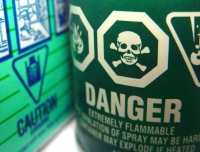Healthy Homes - Household Chemical Safety
How Indoor Air Pollution Can Affect HealthHow does indoor air pollution affect health?
Understanding and controlling common pollutants indoors can help reduce your risk of indoor health concerns. Health effects from indoor air pollutants may be experienced soon after exposure or, possibly, years later.
Immediate Effects
Some health effects may show up shortly after a single exposure or repeated exposures to a pollutant. These include irritation of the eyes, nose, and throat, headaches, dizziness, and fatigue. Such immediate effects are usually short-term and treatable. Sometimes the treatment is simply eliminating the person's exposure to the source of the pollution, if it can be identified. Soon after exposure to some indoor air pollutants, symptoms of some diseases such as asthma may show up, be aggravated or worsened.
The likelihood of immediate reactions to indoor air pollutants depends on several factors including age and preexisting medical conditions. In some cases, whether a person reacts to a pollutant depends on individual sensitivity, which varies tremendously from person to person. Some people can become sensitized to biological or chemical pollutants after repeated or high level exposures.
Certain immediate effects are similar to those from colds or other viral diseases, so it is often difficult to determine if the symptoms are a result of exposure to indoor air pollution. For this reason, it is important to pay attention to the time and place symptoms occur. If the symptoms fade or go away when a person is away from the area, for example, an effort should be made to identify indoor air sources that may be possible causes.
Long-Term Effects
Other health effects may show up either years after exposure has occurred or only after long or repeated periods of exposure. These effects, which include some respiratory diseases, heart disease and cancer, can be severely debilitating or fatal. It is prudent to try to improve the indoor air quality in your home even if symptoms are not noticeable.
While pollutants commonly found in indoor air can cause many harmful effects, there is considerable uncertainty about what concentrations or periods of exposure are necessary to produce specific health problems. People also react very differently to exposure to indoor air pollutants. Further research is needed to better understand which health effects occur after exposure to the average pollutant concentrations found in homes and which occurs from the higher concentrations that occur for short periods of time.
Sources for household contaminants that affect indoor air quality
Chemical contaminants can be found in a variety of sources in the home. Volatile organic compounds (VOCs) are common chemical contaminants found in the home that can easily evaporate into the air. Some products found in the home environment that have the potential to release VOCs include:
- Caulks, sealants, and coatings
- Adhesives
- Paints, varnishes and/or stains
- Wall coverings
- Cleaning agents
- Fuels and combustion products
- Carpeting
- Vinyl flooring
- Fabric materials & furnishings
- Air fresheners and other scented products
- Air purifiers that create ozone
- Personal products of employees like perfume, shampoos, etc.
In addition to household products, be aware of the following indoor air contaminants where a garage is attached to the home:
- General vehicle exhaust (carbon monoxide, oxides of nitrogen)
- Exhaust from gasoline and/or diesel powered vehicles on nearby roads or in parking lots, or garages (carbon monoxide, oxides of nitrogen)
The U.S. Department of Health and Human Services has a Household Product Database where you can learn more about the chemicals in your home.
Safe storage and use of hazardous household products
Always store products in their original containers. Carefully reading the product label will tell you how best to store the product and give important instructions for its use. Always follow all directions on the container. Never mix household chemicals. Always store chemicals in areas protected from the weather, i.e. direct sun or freezing temperatures that could deteriorate the container or affect the hazardous properties of the product. Never store flammable products near heat sources or flames. Always store household chemicals and medications out of the reach of children and pets.
Did you know....?
Did you know that linseed oil, a product commonly used to refinish wood, can spontaneously burst into flames when left on rags or paper towels? A towel that is crumpled up into a ball allows the oil to heat up as it dries. This causes a chemical reaction that leads to fire.
Rags that have absorbed oils such as linseed oil or turpentine should be kept in well-covered metal cans and thoroughly dried before collection or transport to an appropriate household hazardous waste disposal site.
Disposal of household hazardous waste
Proper disposal of unwanted household chemicals is important. Protect your family by getting unwanted chemicals out of your home.
The Tennessee Household Hazardous Waste Program can help with proper disposal. Visit TDEC's website for more information about household hazardous wastes and to find a collection event near you. Check the collection schedule to determine a convenient event for you. If you live in Knox, Hamilton, Davidson, or Shelby Counties, you may take your household hazardous waste to the permanent collection site located in your county.
Tennessee's Unwanted Pharmarceuticals Takeback Program helps individuals safely dispose of their unused or expired medications. Visit TDEC's Unwanted Pharmaceutical Take Back Map to find a location near you.

Additional resources
Tennessee Department of Health
Environmental Health Topics
www.tn.gov/health/cedep/environmental/environmental-health-topics.html
University of Tennessee Agricultural Extension Service
Make Your Home Healthy - Keep It Clean
extension.tennessee.edu/publications/Documents/SP776.pdf
